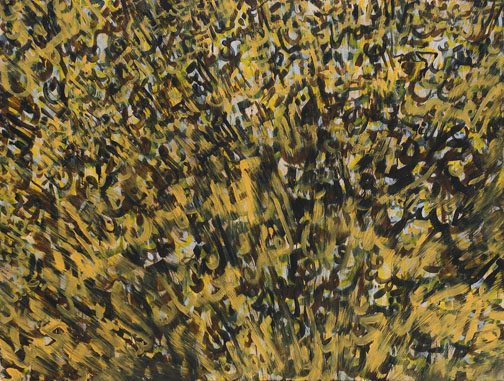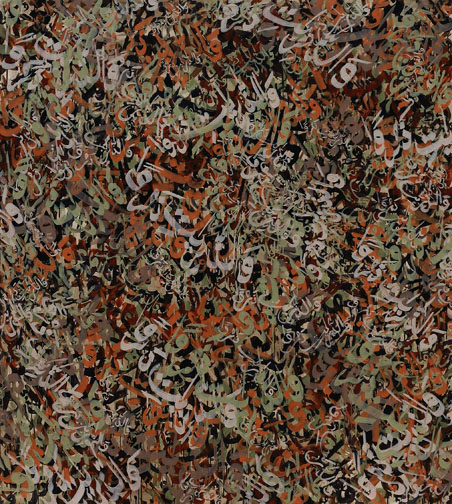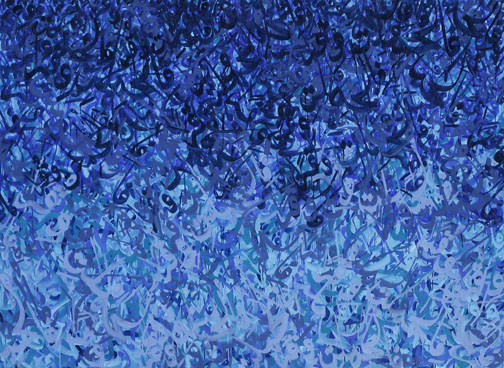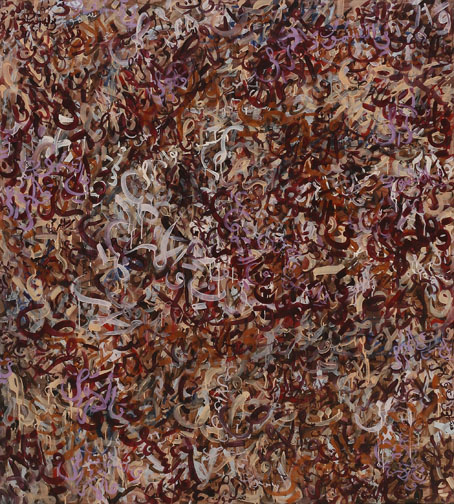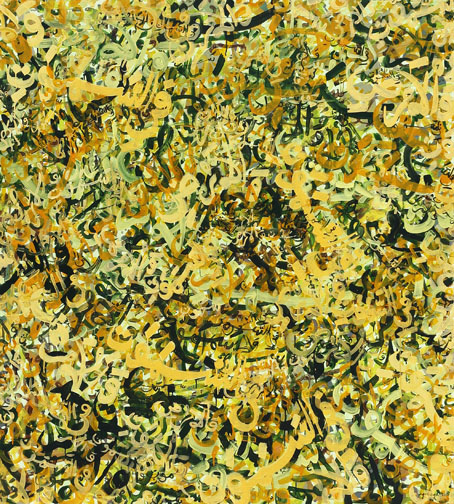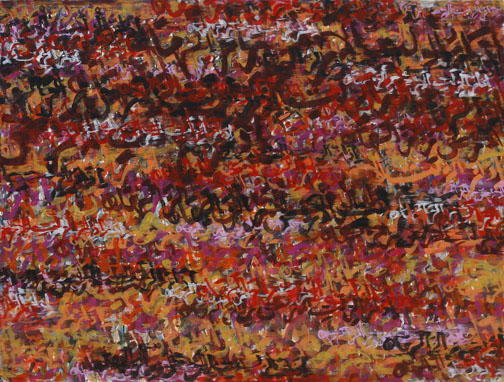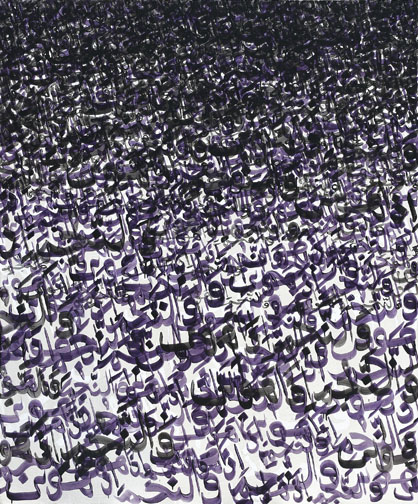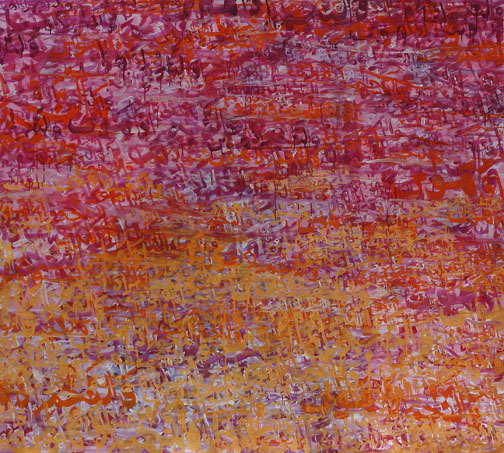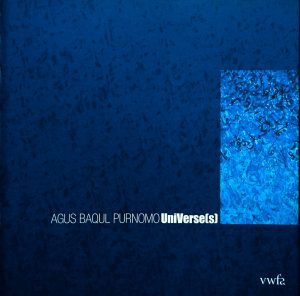Agus Baqul Purnomo
UniVerse(s)
UniVerse(s) at Valentine Willie Fine Art Kuala Lumpur (VWFA KL), is a continuation of Agus Baqul Purnomo’s exploration of Islamic Calligraphy, an ongoing preoccupation for the artist, amongst his other works that deal with abstract styles and compositions. It was around 4 years ago that he became highly focused on calligraphy as one means of expressions, which manifested with the work Yassin (To be Continued) included in the exhibition Ya-Sin Jogja Gallery, 2008. The next year, he elaborated this into a full series of calligraphic works in his solo at VWFA KL, entitled Recite!/ Iqra! a timely exhibition taking place during Ramadhan.
Prior to this, Agus had a solo called Vortex that took nature as its main premise. UniVerse(s) therefore, is a combination of both Recite!/ Iqra! and Vortex: a continuation and expansion on the theme of nature and calligraphy as a style and concept. Initially, it was driven by his experience of coping with the eruption of Mt. Merapi near the city where he lives, Yogyakarta, in October 2010. The greatest eruption in decades, the disaster shocked the country and the world, resulted in thousands of victims and forced refugees to evacuate from their homes. This natural disaster was a tragic reminder of the 2006, earthquake that destroyed many lives and livelihoods in Yogyakarta.
Apart from natural disasters, there have been many things going on in Indonesia lately – such as issues of Islam and pluralism. Somehow, the problems are interrelated with the recent political tensions in the country. Agus’s dual role as a member of society, as well as an artist, forces him therefore, to contemplate much about the forces of nature, spirituality and the conflicting man-made forces around his life; how Man tries to be the center of existence, whilst concurrently being a small presence within the infinite, invincible universe.
Similar with Recite!/ Iqra!, UniVerse(s) also uses verses from the Qur’an. In Recite!/ Iqra!, Agus quoted the most common Surahs that are often used as prayers in the everyday lives of Indonesian Muslim people. In UniVerse(s) he takes less ‘popular’ Surahs, quoting parts of them with verses that have relations or associations with nature. Most of the Surahs themselves serve as contemplations and warnings about the power of God and the forces of nature that are beyond the control of man. Agus recomposes the calligraphic texts of these quotations and rearticulates them in his signature overlapping texts and color compositions that speak of their hidden subtexts.
UniVerse(s) is both a celebration and a reminder. Agus wants to create a tribute to nature, whilst inviting everyone to remember the spirituality and greatness of the universe that hosts our lives; to always remember its power, not with a sense of dread but, with respect and a responsibility to protect.
by Farah Wardani
UniVerse(s) at Valentine Willie Fine Art Kuala Lumpur (VWFA KL) is a continuation of Agus Baqul Purnomo’s exploration of Islamic Calligraphy, an ongoing preoccupation for the artist, amongst other works that deal with abstract styles and compositions. Since 2007 the artist has been highly focused on calligraphy as a means of expression, manifested in the work Yassin (To be Continued) included in the exhibition Ya-Sin, Jogja Gallery, 2008. The next year, he elaborated this into a full series of calligraphic works in his solo at VWFA KL, entitled Recite!/ Iqra!, a timely exhibition taking place during the month of Ramadhan.
Prior to this, Agus had a solo called Vortex that took nature as its main premise. UniVerse(s) therefore, is a combination of both Recite!/ Iqra! and Vortex: a continuation and expansion on the theme of nature and calligraphy as a style and concept. Initially, it was driven by his experience of negotiating the eruption of Mount Merapi near Yogyakarta, the city where he lives, that took place in October 2010. The greatest eruption in decades, the disaster shocked the country and the world, resulting in thousands of victims and making refugees of those forced to evacuate from their homes. This natural disaster was a tragic reminder of the 2006 earthquake that destroyed many lives and livelihoods in Yogyakarta.
Apart from natural disasters, there have been many debates going on in Indonesia lately – such as issues of Islam and pluralism. Somehow, these problems are interrelated with the recent political tensions in the country. Agus’s dual role as a member of society, as well as an artist, forces him therefore, to contemplate on the forces of nature, spirituality and the conflicting man-made forces around his life; how Man tries to be the center of existence, whilst concurrently being a small presence within the infinite, invincible universe.
Similar with Recite!/ Iqra!, UniVerse(s) also uses verses from the Qur’an. In Recite!/ Iqra!, Agus quoted the most common Surahs that are often used as prayers in the everyday lives of Indonesian Muslim people. In UniVerse(s) he takes less popular Surahs, quoting parts of verses that have relations or associations with nature. Most of the Surahs themselves serve as contemplations and warnings about the power of God and the forces of nature that are beyond the control of man. Agus recomposes the calligraphic texts of these quotations and rearticulates them in his signature overlapping texts and color compositions that speak of their hidden subtexts.
The quoted verses are from the following Surahs: Al-Buruuj (The Constellations), Al-Lail (The Night), Al-Zalzalah (The Earthquake), An-Naba (The Announcement), An-Nahl (The Bees), An-Najm (The Star), Ar-Rahman (The Most Gracious), Asy-Syamsi (The Sun), and Az-Zariyat (The Winds That Scatter). Most of the verse titles are depictions of the divine forces of nature. In Recite!/ Iqra!, Agus reproduced verses in their entirety, however in UniVerse(s), he only uses quotations from Surahs that contain the words of these forces, which also serve as the works’ titles. As a result, sentences function more as aphorisms or phrases that lead into different interpretations without reducing their power or original contexts when seen as a whole series.
One of the most striking works is the interpretation of Surah Al-Zalzalah Verse 1: “When the earth is shaken to her (utmost) convulsion”. Meaning earthquake, Agus depicts Al-Zalzalah with distorted, overlapped scriptures in red, terracotta, black and fiery colors, suggesting the colors of magma. Although related to the Mount Merapi eruption and the recent earthquakes occurring in Japan, the Qur’an advises that these apocalyptic signs must be philosophically acknowledged as one of nature’s destructive acts and a necessary part of the cycle of life and death.
Al-Lail Ayat 1, and Al Lail Ayat 2 are inter-related pieces. “By the Night as it envelops”, and “By the Day as it appears” suggest hope and a light after darkness, or the notion of what goes around comes around. Verse 1 is dominated with blue and the colors of twilight, Verse 2 with the colors of the morning, a breezy atmosphere and the fresh colors of the trees. ‘The Night’ is also in conjunction with the work taken from An-Najm that comes in two versions: “By the Star when it descends”, in two extremely different tones of colors. With these works, Agus seems to indicate how nature always comes in dualities: The Sun, The Moon, The Night, The Day, The Shining Stars and The Darkness (when it descends).
There are some works that can be regarded as conclusions that then serve as aphorisms, thus summarising the whole series, such as the one taken from An-Nahl (The Bees): “And He placed mountains as anchors in the Earth so that it may not shake along with you, and streams and roads for you to find course”, smeared with the colors of the grass, mixed with sand-ish grey. It can refer to the refugees of Merapi who lost their livestock, reminding us how the wealth taken from earth’s resources are a precious treasure that we should not take for granted.
The other verses are Ar-Rahman Ayat 5: “The sun and the moon follow courses (exactly) computed”, which is an intriguing pick by Agus, reminding us of the greatly famous and much-quoted refrain of the Surah: “Then which of the favours of your Lord will ye deny?”, a powerful verse that serves as a warning for man to be thankful of all the benefits that has been given by God. Agus composes the piece with exploding letters with dark colors mixed with gold-yellow nuances. This is followed by the series ‘Langit dan Bumi ‘(Heaven and Earth), which is not a direct quote, but serves as a kind of ‘chorus’ of the two words that are often mentioned in the Quranic verses, like in Asy-Syamsi and Al-Buruuj. It depicts the same exploration of colors like Ar-Rahman, but with a separated emphasis with dominating brown-terracota in #1, and yellows in #2, that once again play with dualities.
Such approaches from fresher and more open minded yet, respectable perspectives have yet to be developed further within the Indonesian visual arts scene. At times it is often regarded as something ‘old-fashioned’ or, causing inconvenience, due to certain narrow current interpretations of Islam. As proven by the long history of Islamic arts and also the more contemporary analyses of art of the Islamic world, art practice still offers various ways to create more understanding of the spiritualities and identities of Muslim society, articulating the things that cannot be translated within linguistic barriers, whilst providing a vast range of artistic possibilities in the contemporary art world.
UniVerse(s) is both a celebration and a reminder. Agus wants to create a tribute to nature, inviting us to look once more at the spirituality and greatness of the universe that hosts our lives, and also to always remember its power, without a sense of dread – but rather, with a sense of respect and nurture.
Farah Wardani
